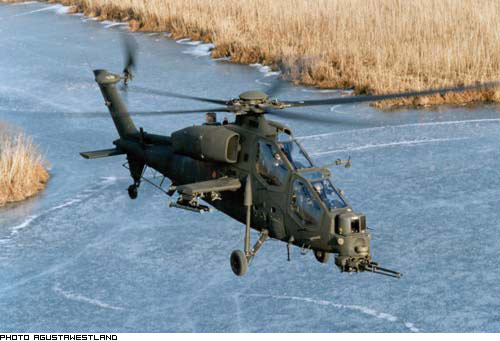A129 Mangusta
Summary
| Category | Military Helicopters |
| Origin country | 🇮🇹 Italy |
| Manufacturer | Agusta |
| First flight | 15 September 1983 |
| Year introduced | 1990 |
| Number produced | 60 units |
| Average unit price | $22 million |
Description
In 1972, the Italian Army identified a need for a light observation and anti-tank helicopter to counter the Warsaw Pact's military strength, a requirement shared by West Germany, leading to a short-lived joint project between Agusta and MBB. Agusta began designing the A129 in 1978, with the first of five prototypes making its maiden flight on September 11, 1983, and the fifth in March 1986. Around the same time, the Italian Army placed an order for 60 A129s, reduced from an initially planned 100. By 1985, the A129 was considered comparable to the American AH-64 Apache.
As the first European attack helicopter, the A129 Mangusta incorporates several original design aspects, including a fully computerized integrated management system aimed at reducing crew workload by automating much of the helicopter's functionality, with onboard computers monitoring and directly controlling parts of the flight and armament systems. Sharing design similarities with the Agusta A109, the A129 features a highly angular and armored fuselage for ballistic protection, while its composite rotor blades are designed to withstand hits from 23mm cannon fire. Power is provided by a pair of Rolls-Royce Gem 2-1004D turboshaft engines equipped with infrared suppressors to minimize the aircraft's heat signature. It is also equipped with an electronic warfare and SIAP self-protection suite. Newer aircraft benefit from laser systems for range-finding and target designation.
The A129 can employ a variety of armaments for both anti-ground and air-to-air missions. For anti-ground roles, it can carry up to eight Hellfire missiles and, from 2014, it could be equipped with the Spike-ER, a fourth-generation anti-tank missile. In the air-to-air role, the Mistral missile is a possible option, and the FIM-92 Stinger missile was certified for use in 2003. The A129 is also capable of carrying 81 mm or 70 mm (2.75 in) unguided rockets housed in pods and 12.7mm machine gun pods. Later models feature a M197 three-barrel 20 mm cannon installed in a nose-mounted Oto Melara TM-197B turret. The A129 has four hardpoints with a capacity of 1500 kg (3,307 lb), with provisions to carry combinations of munitions. It can also carry 4× M260 rocket pods (each with 7× 70 mm (2.75 in) Hydra 70 unguided rockets or 4× M261 rocket pods (each with 19× 70 mm (2.75 in) Hydra 70 unguided rockets. It also can be fitted with 2× missile launchers on each outboard hardpoint with up to 4× BGM-71 TOW or Spike-ER anti-tank guided missiles per launcher, 2× missile launchers on each outboard hardpoint with up to 2× AIM-92 Stinger anti-aircraft missiles. The aircraft may be fitted with 2× FN Herstal ETNA TMP-5 pods with 2× 7.62 mm (.30 in) FN MAG 58P machine guns (each 500 rounds) and 2× FN-Herstal HMP-400LC pods with 1× 12.7 mm (.50 in) M2 machine gun (400 rounds). It may also carry 2× external fuel tanks (220 Liter (52.8 gal).
The A129 Mangusta has participated in several United Nations missions, including deployments to the Republic of Macedonia, Somalia, and Angola. It proved well-suited to peacekeeping operations and hot climates, demonstrating high reliability and flexibility during its deployment to Somalia. In Iraq, three A129 helicopters provided air support for Italian forces in Nassiriya. Additionally, several A129s have been stationed in Afghanistan, supporting Italian and allied operations. The latest variant, the AW-129D, was first deployed to Afghanistan in November 2014.
Main Variants:
-
A129 Mangusta: The original production version, powered by two Rolls-Royce Gem 2 turboshaft engines, with a maximum takeoff weight of 4,100 kg, primarily operated by the Italian Army.
-
A129 International: An upgraded export version featuring more powerful LHTEC T800 turboshafts, a five-bladed main rotor, improved transmission and avionics, and support for Hellfire and Stinger missiles, with a maximum takeoff weight of 5,000 kg.
-
A129 CBT / A129C: An upgraded "Combat" version for the Italian Army that incorporates most of the A129 International's features but retains the original Gem turboshaft engines (though with an uprated transmission), utilizing TOW missiles as its main anti-tank weapon and equipped with auxiliary fuel tanks and Stinger missiles, with a maximum takeoff weight of 4,600 kg.
-
A129D (AgustaWestland AW129D): An updated version of the A129C with improved avionics, multifunctional displays, and a Rafael TopLite III optronic system, replacing TOW missiles with modern Spike-ER missiles, and has a maximum takeoff weight of 4,600 kg.
-
T129 ATAK: A Turkish attack helicopter based on the A129 International, distinguished by Turkish-made avionics and weaponry.
Technical specifications
| Version: AH-129 | |
|---|---|
| Crew | 2 members |
| Operational range | 560 km (348 mi) |
| Maximum speed | 278 km/h (173 mph) |
| Wingspan | 11.9 m (39.0 ft) |
| Height | 3.4 m (11.0 ft) |
| Length | 12.3 m (40.3 ft) |
| Service ceiling | 4,724 m (15,499 ft) |
| Empty weight | 2,530 kg (5,578 lbs) |
| Max. takeoff weight | 4,600 kg (10,141 lbs) |
| Climb rate | 10.2 m/s (33.5 ft/s) |
| Powerplant | 2 x turboprops Rolls-Royce Gem 2-1004D delivering 664 kW each |
Current operating countries
| Country | Units | ||
|---|---|---|---|

|
Turkey | 58 (+41) | |

|
Italy | 37 | |

|
Philippines | 6 (+6) | |

|
Nigeria | 4 (+2) | |

|
Pakistan | 0 (+30) | |
All operators
Armament
Missiles payload:
- Anti-Tank BGM-71 TOW
- Air-to-Air Short-Range General Dynamics AIM-92 Stinger
- Anti-Tank Lockheed-Martin AGM-114 Hellfire
- Air-to-Air Short-Range Mistral

